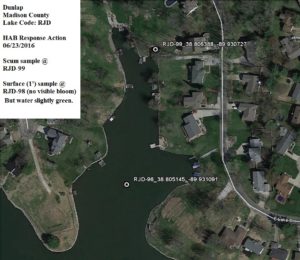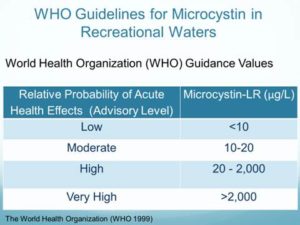EPA’s Report July 6, 2017
The EPA collected two samples on June 23rd. One was taken back along the shore where a blue-green algae bloom was reported and one was out in the mouth of the same cove. The level of microcystin (toxin) was:
- 36.2 ug/L near the shore (as reported previously)
- 0.38 ug/L In the mouth of the cove (as reported today)
Today’s e-mail from the EPA included these comments:
“Although microcystins were detected in this sample, they were detected at a much lower concentration compared to the sample collected near the resident’s dock (36.2 ug/L). The 0.38 ug/L concentration is well below all advisory thresholds associated with recreational risk due to microcystin exposure.
We are currently not planning to return to your lake to collect follow-up algal-toxin samples. We thought it was important to try to reduce any potential health risks to children participating in the fishing derby.
I think we learned a couple of important things about your lake as a result of that visit. First, we learned that the blue-green algae forming scums in your lake do have the potential to produce toxins that exceed recreational thresholds. That is important so that when you see scums like you are currently experiencing, you can advise people to avoid the water in the scum area and to keep children and pets away also.
Secondly, we learned that although there may be toxins in the open water areas away from the scums, we found them to be very low compared to the scum areas. It is always best to use professional judgement and to err on the side of caution if you want to recreate in natural lakes and ponds. If the water looks like it could be experiencing a cyanobacteria bloom, you should assume it is not safe to recreate in.
Just today, I received new information from USEPA on monitoring and responding to cyanobacteria and cyanotoxins in recreational waters that may be of interest to you. Information can be found at the following link https://www.epa.gov/nutrient-policy-data/monitoring-and-responding-cyanobacteria-and-cyanotoxins-recreational-waters?utm_medium=email&utm_source=govdelivery#t3.
———————————-
In response, Dunlap Lake Property Owners Association will be looking into the monitoring resources received today and the communications tools recently released to support those efforts. There are no commercial labs in the State of Illinois to do these analyses but there is an Illinois Voluntary Lake Monitoring program and national labs that may be able to test.
If you have the expertise to help develop a monitoring system, are interested in being on the safety committee, or can be out on the lake helping to monitor, please respond to this e-mail.
Remember: not seeing scum on top of the water does not automatically make the water safe. In the area with the high toxin levels, there was scum in the mornings and it was clear in the evenings. If you see scum please email manager@DunlapLake.org or call Carolyn Green to get a caution sign placed in the affected area to protect small children and pets by letting parents and owners know to keep them away from coves where scum has been sited.
Test samples were both taken in the cove on the south side of Park Street per the GPS coordinates in the photo below.
EPA’s Report July 6, 2017
The EPA collected two samples on June 23rd. One was taken back along the shore where a blue-green algae bloom was reported and one was out in the mouth of the same cove. The level of microcystin (toxin) was:
- 36.2 ug/L near the shore (as reported previously)
- 0.38 ug/L In the mouth of the cove (as reported today)
Today’s e-mail from the EPA included these comments:
“Although microcystins were detected in this sample, they were detected at a much lower concentration compared to the sample collected near the resident’s dock (36.2 ug/L). The 0.38 ug/L concentration is well below all advisory thresholds associated with recreational risk due to microcystin exposure.
We are currently not planning to return to your lake to collect follow-up algal-toxin samples. We thought it was important to try to reduce any potential health risks to children participating in the fishing derby.
I think we learned a couple of important things about your lake as a result of that visit. First, we learned that the blue-green algae forming scums in your lake do have the potential to produce toxins that exceed recreational thresholds. That is important so that when you see scums like you are currently experiencing, you can advise people to avoid the water in the scum area and to keep children and pets away also.
Secondly, we learned that although there may be toxins in the open water areas away from the scums, we found them to be very low compared to the scum areas. It is always best to use professional judgement and to err on the side of caution if you want to recreate in natural lakes and ponds. If the water looks like it could be experiencing a cyanobacteria bloom, you should assume it is not safe to recreate in.
Just today, I received new information from USEPA on monitoring and responding to cyanobacteria and cyanotoxins in recreational waters that may be of interest to you. Information can be found at the following link https://www.epa.gov/nutrient-policy-data/monitoring-and-responding-cyanobacteria-and-cyanotoxins-recreational-waters?utm_medium=email&utm_source=govdelivery#t3.
———————————-
In response, Dunlap Lake Property Owners Association will be looking into the monitoring resources received today and the communications tools recently released to support those efforts. There are no commercial labs in the State of Illinois to do these analyses but there is an Illinois Voluntary Lake Monitoring program and national labs that may be able to test.
If you have the expertise to help develop a monitoring system, are interested in being on the safety committee, or can be out on the lake helping to monitor, please respond to this e-mail.
Remember: not seeing scum on top of the water does not automatically make the water safe. In the area with the high toxin levels, there was scum in the mornings and it was clear in the evenings. If you see scum please email manager@DunlapLake.org or call Carolyn Green to get a caution sign placed in the affected area to protect small children and pets by letting parents and owners know to keep them away from coves where scum has been sited.
Test samples were both taken in the cove on the south side of Park Street per the GPS coordinates in the photo below.


